Experimental Analysis: Jet Impingement Cooling and Erosion-Corrosion
VerifiedAdded on 2023/03/29
|11
|2019
|298
Report
AI Summary
This report presents an experimental investigation into jet impingement cooling and erosion-corrosion of stainless steels. The jet impingement section explores heat transfer characteristics using nanofluids with varying concentrations and different jet-to-target distances. It details the experimental setup, including the jet impingement system and test module, and discusses the preparation and use of CU-water nanofluids. The erosion-corrosion section focuses on the degradation process of materials under combined electrochemical and mechanical wear conditions. It describes the experimental procedure, including the use of an Alicona 3D Infinite Focus Laser for surface roughness measurements and wear scar analysis. Different stainless steel alloys were tested under varying impingement angles and solution compositions. The report concludes by highlighting the importance of jet-to-target distance in jet impingement heat transfer and the suitability of the Alicona device for estimating material removal in erosion-corrosion scenarios. Desklib provides access to similar project reports and study resources for students.
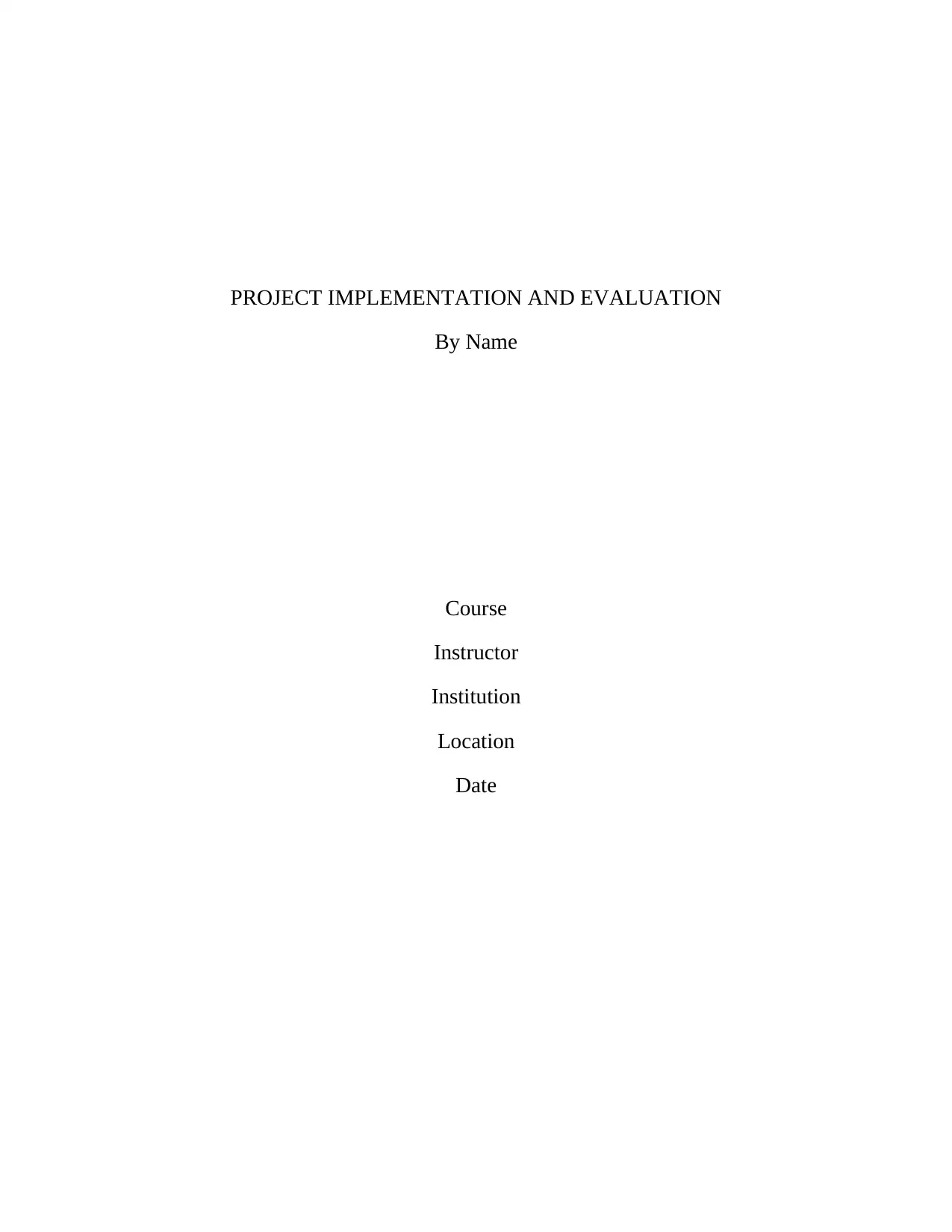
PROJECT IMPLEMENTATION AND EVALUATION
By Name
Course
Instructor
Institution
Location
Date
By Name
Course
Instructor
Institution
Location
Date
Paraphrase This Document
Need a fresh take? Get an instant paraphrase of this document with our AI Paraphraser
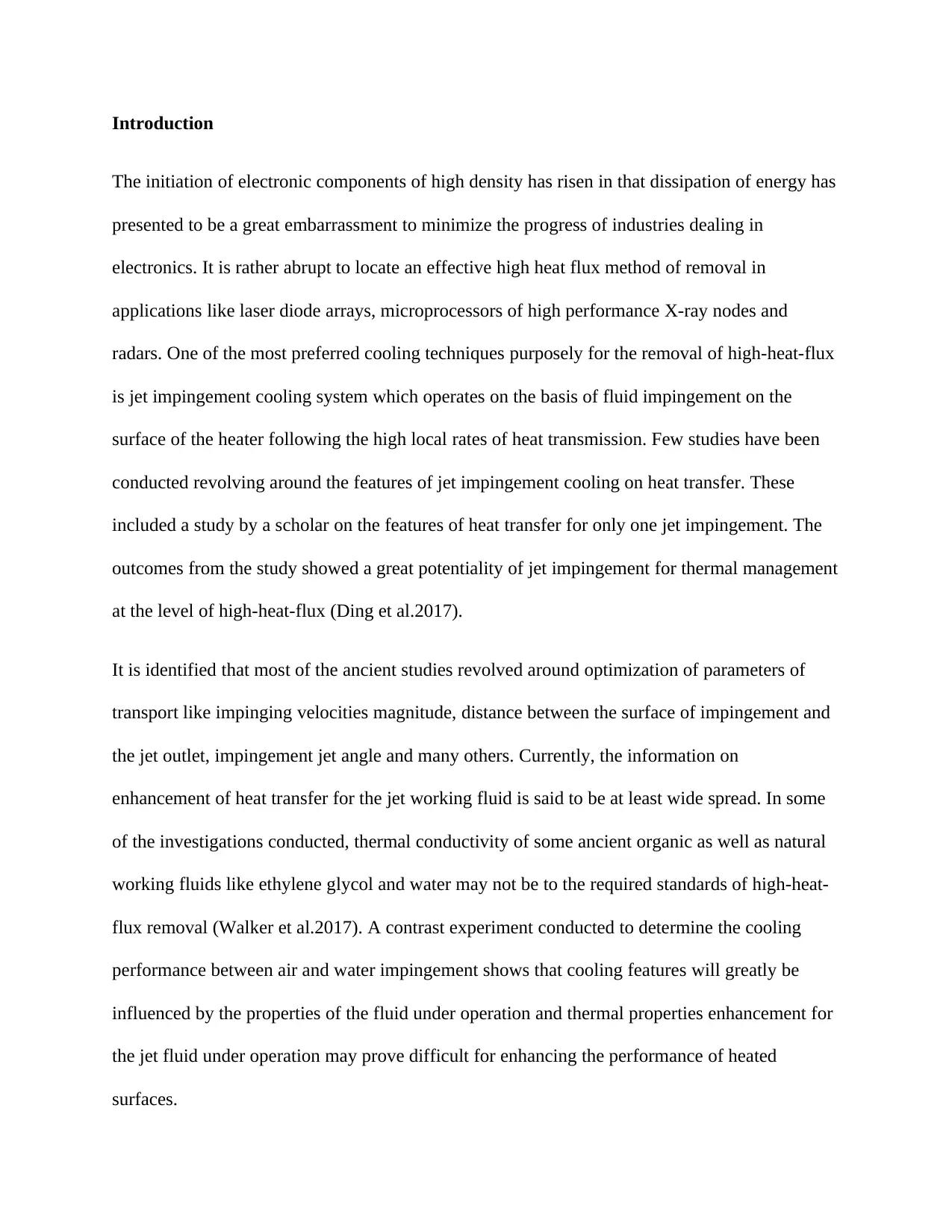
Introduction
The initiation of electronic components of high density has risen in that dissipation of energy has
presented to be a great embarrassment to minimize the progress of industries dealing in
electronics. It is rather abrupt to locate an effective high heat flux method of removal in
applications like laser diode arrays, microprocessors of high performance X-ray nodes and
radars. One of the most preferred cooling techniques purposely for the removal of high-heat-flux
is jet impingement cooling system which operates on the basis of fluid impingement on the
surface of the heater following the high local rates of heat transmission. Few studies have been
conducted revolving around the features of jet impingement cooling on heat transfer. These
included a study by a scholar on the features of heat transfer for only one jet impingement. The
outcomes from the study showed a great potentiality of jet impingement for thermal management
at the level of high-heat-flux (Ding et al.2017).
It is identified that most of the ancient studies revolved around optimization of parameters of
transport like impinging velocities magnitude, distance between the surface of impingement and
the jet outlet, impingement jet angle and many others. Currently, the information on
enhancement of heat transfer for the jet working fluid is said to be at least wide spread. In some
of the investigations conducted, thermal conductivity of some ancient organic as well as natural
working fluids like ethylene glycol and water may not be to the required standards of high-heat-
flux removal (Walker et al.2017). A contrast experiment conducted to determine the cooling
performance between air and water impingement shows that cooling features will greatly be
influenced by the properties of the fluid under operation and thermal properties enhancement for
the jet fluid under operation may prove difficult for enhancing the performance of heated
surfaces.
The initiation of electronic components of high density has risen in that dissipation of energy has
presented to be a great embarrassment to minimize the progress of industries dealing in
electronics. It is rather abrupt to locate an effective high heat flux method of removal in
applications like laser diode arrays, microprocessors of high performance X-ray nodes and
radars. One of the most preferred cooling techniques purposely for the removal of high-heat-flux
is jet impingement cooling system which operates on the basis of fluid impingement on the
surface of the heater following the high local rates of heat transmission. Few studies have been
conducted revolving around the features of jet impingement cooling on heat transfer. These
included a study by a scholar on the features of heat transfer for only one jet impingement. The
outcomes from the study showed a great potentiality of jet impingement for thermal management
at the level of high-heat-flux (Ding et al.2017).
It is identified that most of the ancient studies revolved around optimization of parameters of
transport like impinging velocities magnitude, distance between the surface of impingement and
the jet outlet, impingement jet angle and many others. Currently, the information on
enhancement of heat transfer for the jet working fluid is said to be at least wide spread. In some
of the investigations conducted, thermal conductivity of some ancient organic as well as natural
working fluids like ethylene glycol and water may not be to the required standards of high-heat-
flux removal (Walker et al.2017). A contrast experiment conducted to determine the cooling
performance between air and water impingement shows that cooling features will greatly be
influenced by the properties of the fluid under operation and thermal properties enhancement for
the jet fluid under operation may prove difficult for enhancing the performance of heated
surfaces.
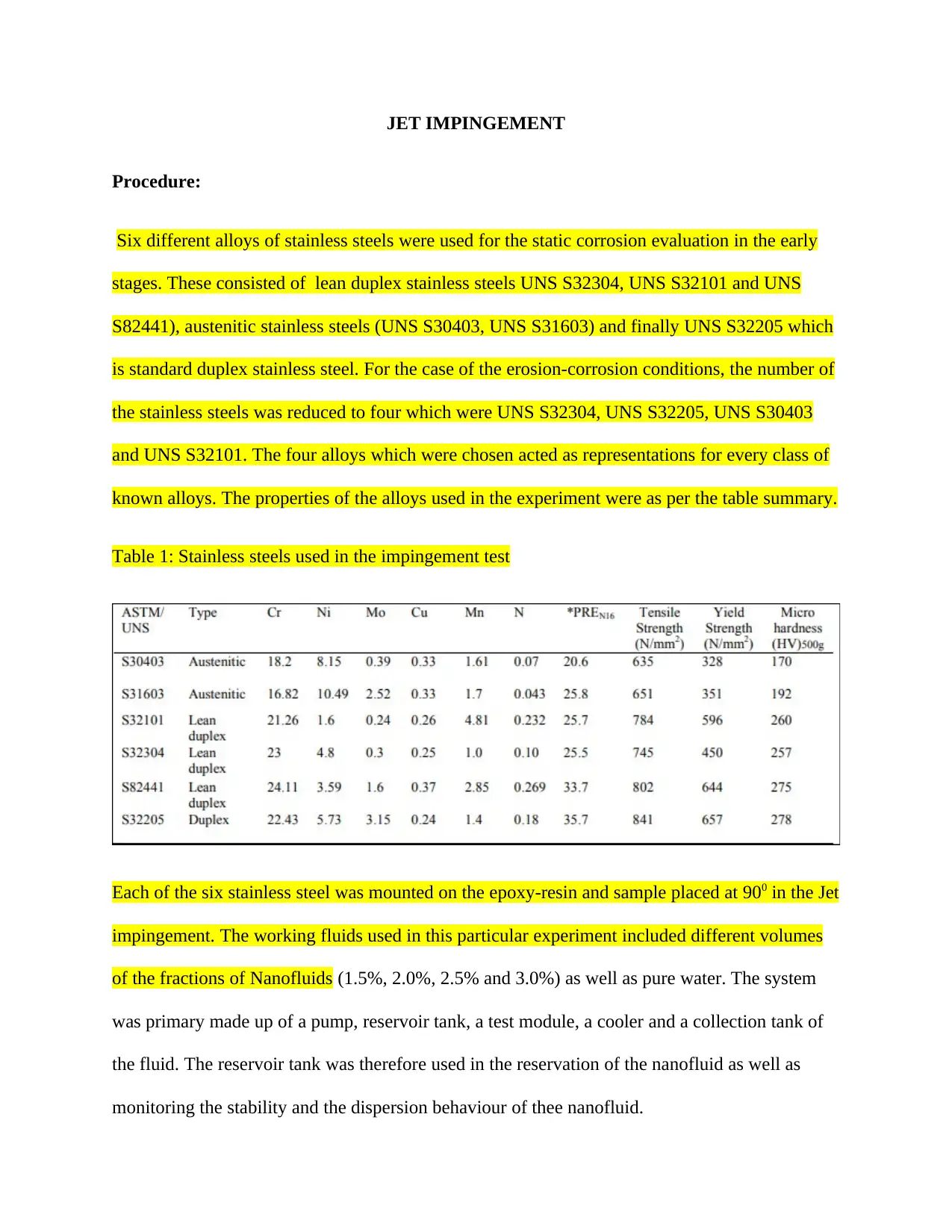
JET IMPINGEMENT
Procedure:
Six different alloys of stainless steels were used for the static corrosion evaluation in the early
stages. These consisted of lean duplex stainless steels UNS S32304, UNS S32101 and UNS
S82441), austenitic stainless steels (UNS S30403, UNS S31603) and finally UNS S32205 which
is standard duplex stainless steel. For the case of the erosion-corrosion conditions, the number of
the stainless steels was reduced to four which were UNS S32304, UNS S32205, UNS S30403
and UNS S32101. The four alloys which were chosen acted as representations for every class of
known alloys. The properties of the alloys used in the experiment were as per the table summary.
Table 1: Stainless steels used in the impingement test
Each of the six stainless steel was mounted on the epoxy-resin and sample placed at 900 in the Jet
impingement. The working fluids used in this particular experiment included different volumes
of the fractions of Nanofluids (1.5%, 2.0%, 2.5% and 3.0%) as well as pure water. The system
was primary made up of a pump, reservoir tank, a test module, a cooler and a collection tank of
the fluid. The reservoir tank was therefore used in the reservation of the nanofluid as well as
monitoring the stability and the dispersion behaviour of thee nanofluid.
Procedure:
Six different alloys of stainless steels were used for the static corrosion evaluation in the early
stages. These consisted of lean duplex stainless steels UNS S32304, UNS S32101 and UNS
S82441), austenitic stainless steels (UNS S30403, UNS S31603) and finally UNS S32205 which
is standard duplex stainless steel. For the case of the erosion-corrosion conditions, the number of
the stainless steels was reduced to four which were UNS S32304, UNS S32205, UNS S30403
and UNS S32101. The four alloys which were chosen acted as representations for every class of
known alloys. The properties of the alloys used in the experiment were as per the table summary.
Table 1: Stainless steels used in the impingement test
Each of the six stainless steel was mounted on the epoxy-resin and sample placed at 900 in the Jet
impingement. The working fluids used in this particular experiment included different volumes
of the fractions of Nanofluids (1.5%, 2.0%, 2.5% and 3.0%) as well as pure water. The system
was primary made up of a pump, reservoir tank, a test module, a cooler and a collection tank of
the fluid. The reservoir tank was therefore used in the reservation of the nanofluid as well as
monitoring the stability and the dispersion behaviour of thee nanofluid.
⊘ This is a preview!⊘
Do you want full access?
Subscribe today to unlock all pages.

Trusted by 1+ million students worldwide
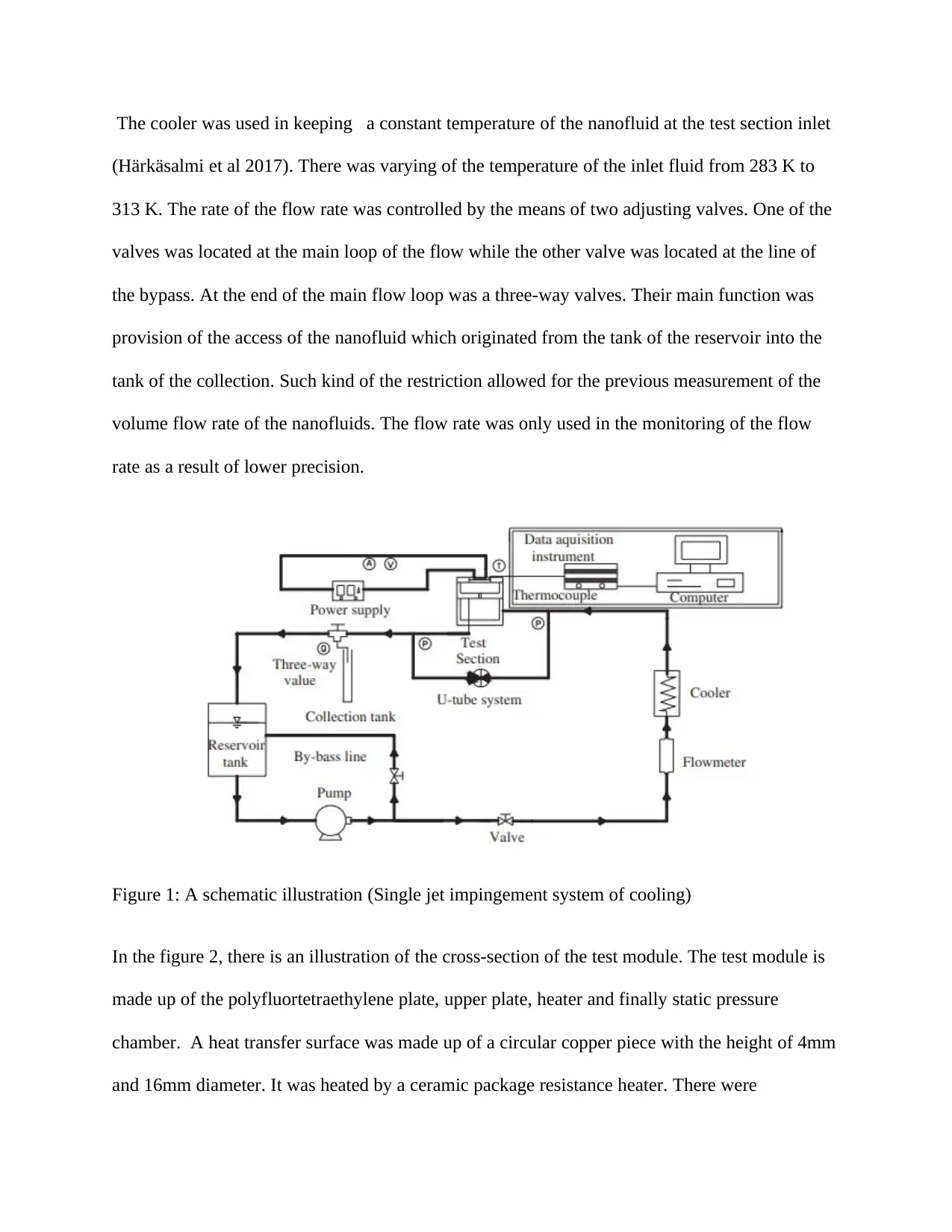
The cooler was used in keeping a constant temperature of the nanofluid at the test section inlet
(Härkäsalmi et al 2017). There was varying of the temperature of the inlet fluid from 283 K to
313 K. The rate of the flow rate was controlled by the means of two adjusting valves. One of the
valves was located at the main loop of the flow while the other valve was located at the line of
the bypass. At the end of the main flow loop was a three-way valves. Their main function was
provision of the access of the nanofluid which originated from the tank of the reservoir into the
tank of the collection. Such kind of the restriction allowed for the previous measurement of the
volume flow rate of the nanofluids. The flow rate was only used in the monitoring of the flow
rate as a result of lower precision.
Figure 1: A schematic illustration (Single jet impingement system of cooling)
In the figure 2, there is an illustration of the cross-section of the test module. The test module is
made up of the polyfluortetraethylene plate, upper plate, heater and finally static pressure
chamber. A heat transfer surface was made up of a circular copper piece with the height of 4mm
and 16mm diameter. It was heated by a ceramic package resistance heater. There were
(Härkäsalmi et al 2017). There was varying of the temperature of the inlet fluid from 283 K to
313 K. The rate of the flow rate was controlled by the means of two adjusting valves. One of the
valves was located at the main loop of the flow while the other valve was located at the line of
the bypass. At the end of the main flow loop was a three-way valves. Their main function was
provision of the access of the nanofluid which originated from the tank of the reservoir into the
tank of the collection. Such kind of the restriction allowed for the previous measurement of the
volume flow rate of the nanofluids. The flow rate was only used in the monitoring of the flow
rate as a result of lower precision.
Figure 1: A schematic illustration (Single jet impingement system of cooling)
In the figure 2, there is an illustration of the cross-section of the test module. The test module is
made up of the polyfluortetraethylene plate, upper plate, heater and finally static pressure
chamber. A heat transfer surface was made up of a circular copper piece with the height of 4mm
and 16mm diameter. It was heated by a ceramic package resistance heater. There were
Paraphrase This Document
Need a fresh take? Get an instant paraphrase of this document with our AI Paraphraser
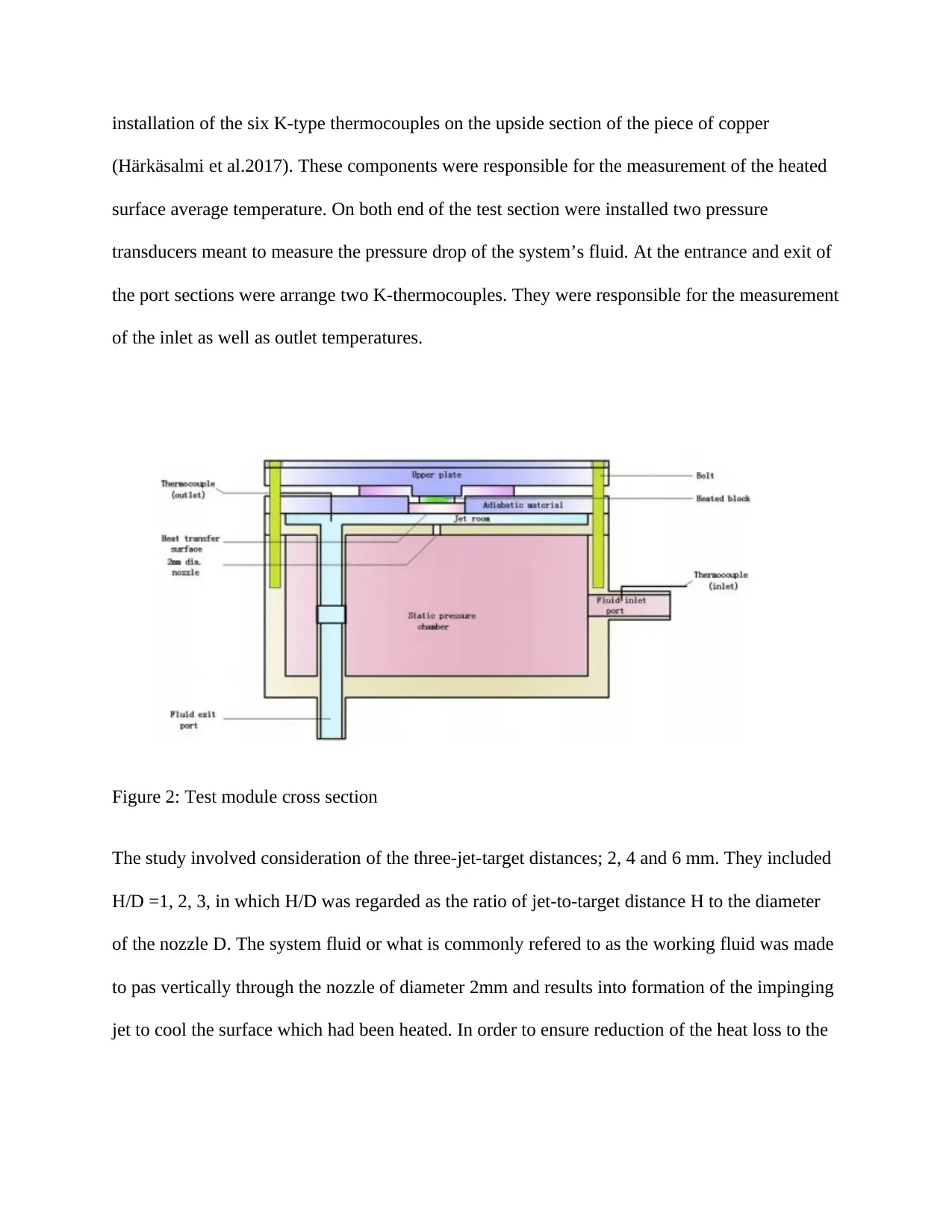
installation of the six K-type thermocouples on the upside section of the piece of copper
(Härkäsalmi et al.2017). These components were responsible for the measurement of the heated
surface average temperature. On both end of the test section were installed two pressure
transducers meant to measure the pressure drop of the system’s fluid. At the entrance and exit of
the port sections were arrange two K-thermocouples. They were responsible for the measurement
of the inlet as well as outlet temperatures.
Figure 2: Test module cross section
The study involved consideration of the three-jet-target distances; 2, 4 and 6 mm. They included
H/D =1, 2, 3, in which H/D was regarded as the ratio of jet-to-target distance H to the diameter
of the nozzle D. The system fluid or what is commonly refered to as the working fluid was made
to pas vertically through the nozzle of diameter 2mm and results into formation of the impinging
jet to cool the surface which had been heated. In order to ensure reduction of the heat loss to the
(Härkäsalmi et al.2017). These components were responsible for the measurement of the heated
surface average temperature. On both end of the test section were installed two pressure
transducers meant to measure the pressure drop of the system’s fluid. At the entrance and exit of
the port sections were arrange two K-thermocouples. They were responsible for the measurement
of the inlet as well as outlet temperatures.
Figure 2: Test module cross section
The study involved consideration of the three-jet-target distances; 2, 4 and 6 mm. They included
H/D =1, 2, 3, in which H/D was regarded as the ratio of jet-to-target distance H to the diameter
of the nozzle D. The system fluid or what is commonly refered to as the working fluid was made
to pas vertically through the nozzle of diameter 2mm and results into formation of the impinging
jet to cool the surface which had been heated. In order to ensure reduction of the heat loss to the
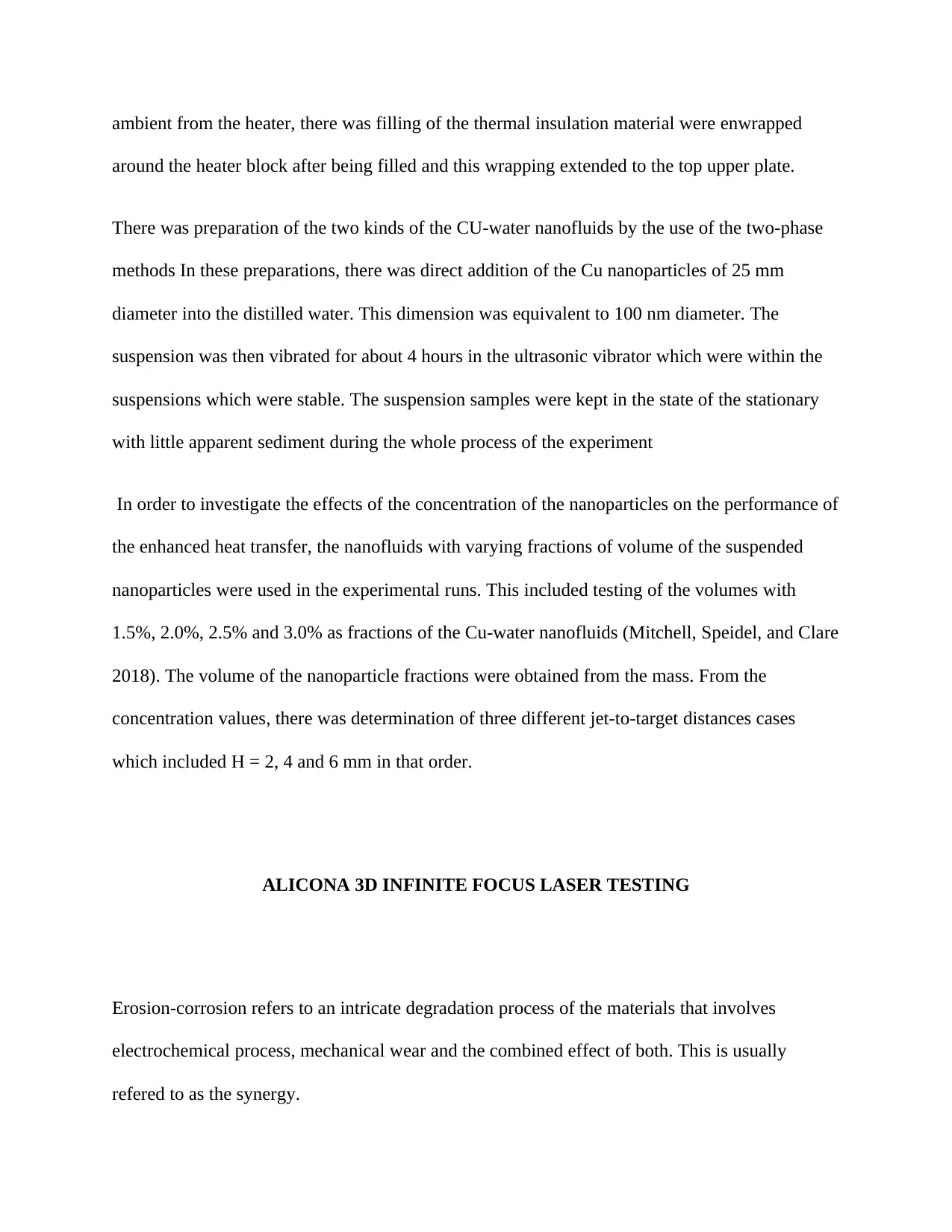
ambient from the heater, there was filling of the thermal insulation material were enwrapped
around the heater block after being filled and this wrapping extended to the top upper plate.
There was preparation of the two kinds of the CU-water nanofluids by the use of the two-phase
methods In these preparations, there was direct addition of the Cu nanoparticles of 25 mm
diameter into the distilled water. This dimension was equivalent to 100 nm diameter. The
suspension was then vibrated for about 4 hours in the ultrasonic vibrator which were within the
suspensions which were stable. The suspension samples were kept in the state of the stationary
with little apparent sediment during the whole process of the experiment
In order to investigate the effects of the concentration of the nanoparticles on the performance of
the enhanced heat transfer, the nanofluids with varying fractions of volume of the suspended
nanoparticles were used in the experimental runs. This included testing of the volumes with
1.5%, 2.0%, 2.5% and 3.0% as fractions of the Cu-water nanofluids (Mitchell, Speidel, and Clare
2018). The volume of the nanoparticle fractions were obtained from the mass. From the
concentration values, there was determination of three different jet-to-target distances cases
which included H = 2, 4 and 6 mm in that order.
ALICONA 3D INFINITE FOCUS LASER TESTING
Erosion-corrosion refers to an intricate degradation process of the materials that involves
electrochemical process, mechanical wear and the combined effect of both. This is usually
refered to as the synergy.
around the heater block after being filled and this wrapping extended to the top upper plate.
There was preparation of the two kinds of the CU-water nanofluids by the use of the two-phase
methods In these preparations, there was direct addition of the Cu nanoparticles of 25 mm
diameter into the distilled water. This dimension was equivalent to 100 nm diameter. The
suspension was then vibrated for about 4 hours in the ultrasonic vibrator which were within the
suspensions which were stable. The suspension samples were kept in the state of the stationary
with little apparent sediment during the whole process of the experiment
In order to investigate the effects of the concentration of the nanoparticles on the performance of
the enhanced heat transfer, the nanofluids with varying fractions of volume of the suspended
nanoparticles were used in the experimental runs. This included testing of the volumes with
1.5%, 2.0%, 2.5% and 3.0% as fractions of the Cu-water nanofluids (Mitchell, Speidel, and Clare
2018). The volume of the nanoparticle fractions were obtained from the mass. From the
concentration values, there was determination of three different jet-to-target distances cases
which included H = 2, 4 and 6 mm in that order.
ALICONA 3D INFINITE FOCUS LASER TESTING
Erosion-corrosion refers to an intricate degradation process of the materials that involves
electrochemical process, mechanical wear and the combined effect of both. This is usually
refered to as the synergy.
⊘ This is a preview!⊘
Do you want full access?
Subscribe today to unlock all pages.

Trusted by 1+ million students worldwide
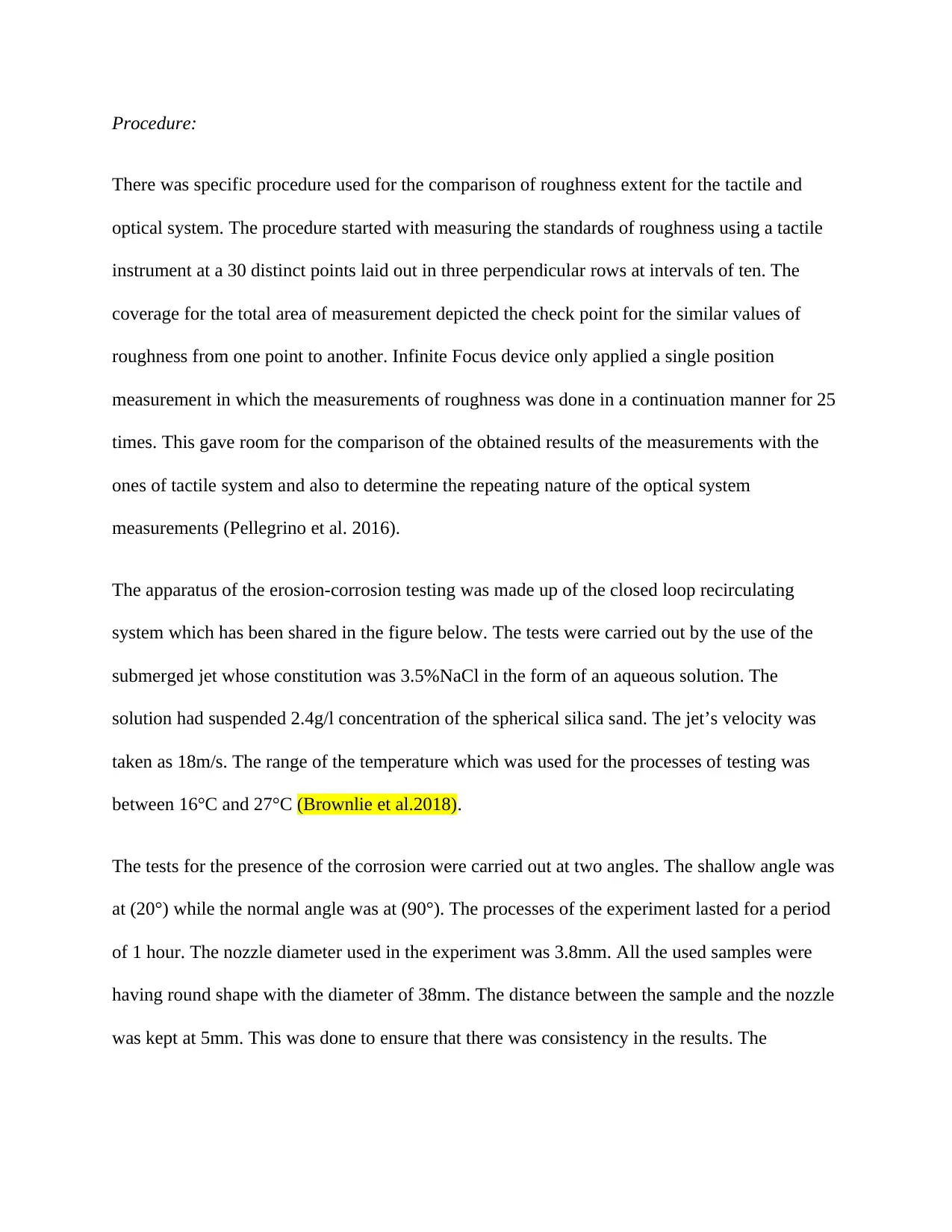
Procedure:
There was specific procedure used for the comparison of roughness extent for the tactile and
optical system. The procedure started with measuring the standards of roughness using a tactile
instrument at a 30 distinct points laid out in three perpendicular rows at intervals of ten. The
coverage for the total area of measurement depicted the check point for the similar values of
roughness from one point to another. Infinite Focus device only applied a single position
measurement in which the measurements of roughness was done in a continuation manner for 25
times. This gave room for the comparison of the obtained results of the measurements with the
ones of tactile system and also to determine the repeating nature of the optical system
measurements (Pellegrino et al. 2016).
The apparatus of the erosion-corrosion testing was made up of the closed loop recirculating
system which has been shared in the figure below. The tests were carried out by the use of the
submerged jet whose constitution was 3.5%NaCl in the form of an aqueous solution. The
solution had suspended 2.4g/l concentration of the spherical silica sand. The jet’s velocity was
taken as 18m/s. The range of the temperature which was used for the processes of testing was
between 16°C and 27°C (Brownlie et al.2018).
The tests for the presence of the corrosion were carried out at two angles. The shallow angle was
at (20°) while the normal angle was at (90°). The processes of the experiment lasted for a period
of 1 hour. The nozzle diameter used in the experiment was 3.8mm. All the used samples were
having round shape with the diameter of 38mm. The distance between the sample and the nozzle
was kept at 5mm. This was done to ensure that there was consistency in the results. The
There was specific procedure used for the comparison of roughness extent for the tactile and
optical system. The procedure started with measuring the standards of roughness using a tactile
instrument at a 30 distinct points laid out in three perpendicular rows at intervals of ten. The
coverage for the total area of measurement depicted the check point for the similar values of
roughness from one point to another. Infinite Focus device only applied a single position
measurement in which the measurements of roughness was done in a continuation manner for 25
times. This gave room for the comparison of the obtained results of the measurements with the
ones of tactile system and also to determine the repeating nature of the optical system
measurements (Pellegrino et al. 2016).
The apparatus of the erosion-corrosion testing was made up of the closed loop recirculating
system which has been shared in the figure below. The tests were carried out by the use of the
submerged jet whose constitution was 3.5%NaCl in the form of an aqueous solution. The
solution had suspended 2.4g/l concentration of the spherical silica sand. The jet’s velocity was
taken as 18m/s. The range of the temperature which was used for the processes of testing was
between 16°C and 27°C (Brownlie et al.2018).
The tests for the presence of the corrosion were carried out at two angles. The shallow angle was
at (20°) while the normal angle was at (90°). The processes of the experiment lasted for a period
of 1 hour. The nozzle diameter used in the experiment was 3.8mm. All the used samples were
having round shape with the diameter of 38mm. The distance between the sample and the nozzle
was kept at 5mm. This was done to ensure that there was consistency in the results. The
Paraphrase This Document
Need a fresh take? Get an instant paraphrase of this document with our AI Paraphraser
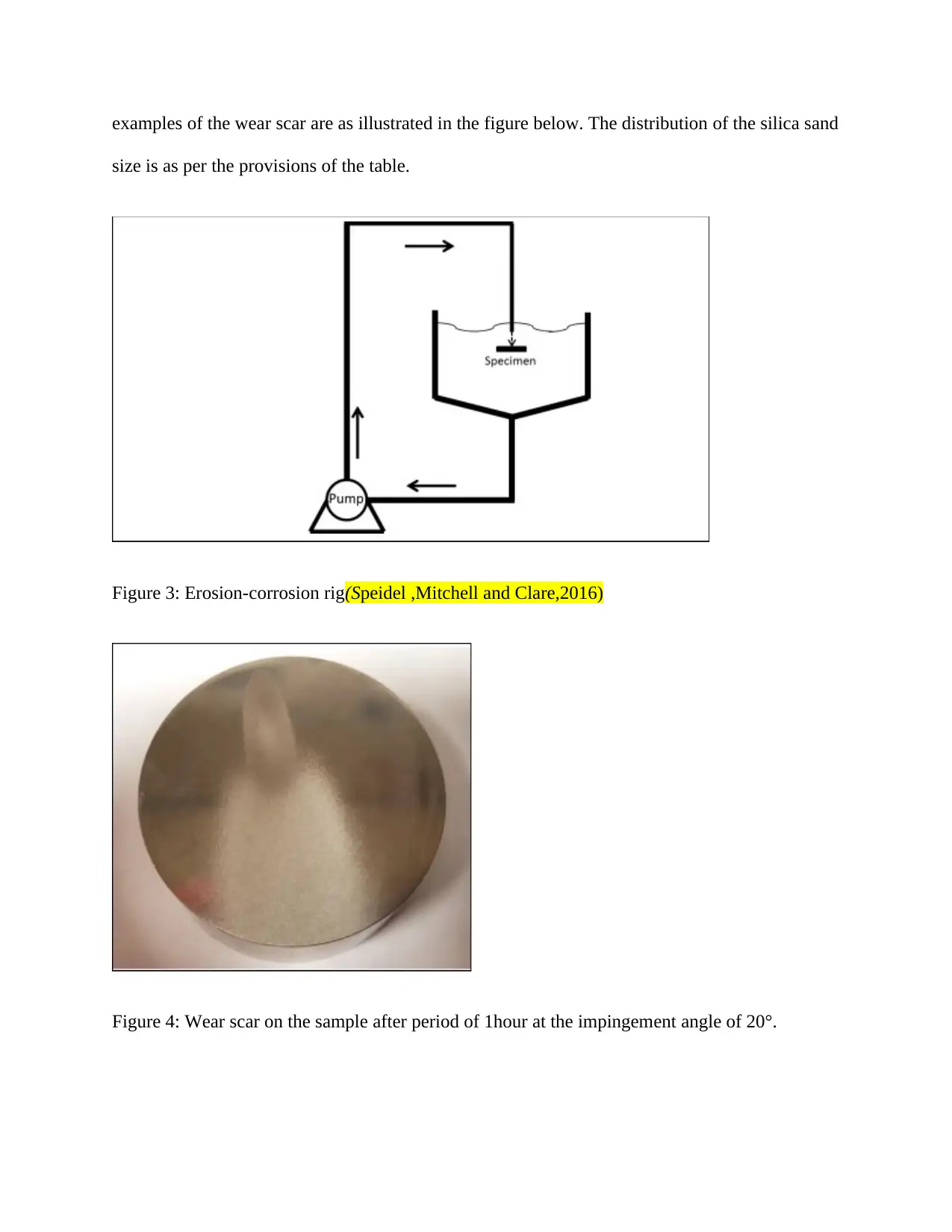
examples of the wear scar are as illustrated in the figure below. The distribution of the silica sand
size is as per the provisions of the table.
Figure 3: Erosion-corrosion rig(Speidel ,Mitchell and Clare,2016)
Figure 4: Wear scar on the sample after period of 1hour at the impingement angle of 20°.
size is as per the provisions of the table.
Figure 3: Erosion-corrosion rig(Speidel ,Mitchell and Clare,2016)
Figure 4: Wear scar on the sample after period of 1hour at the impingement angle of 20°.
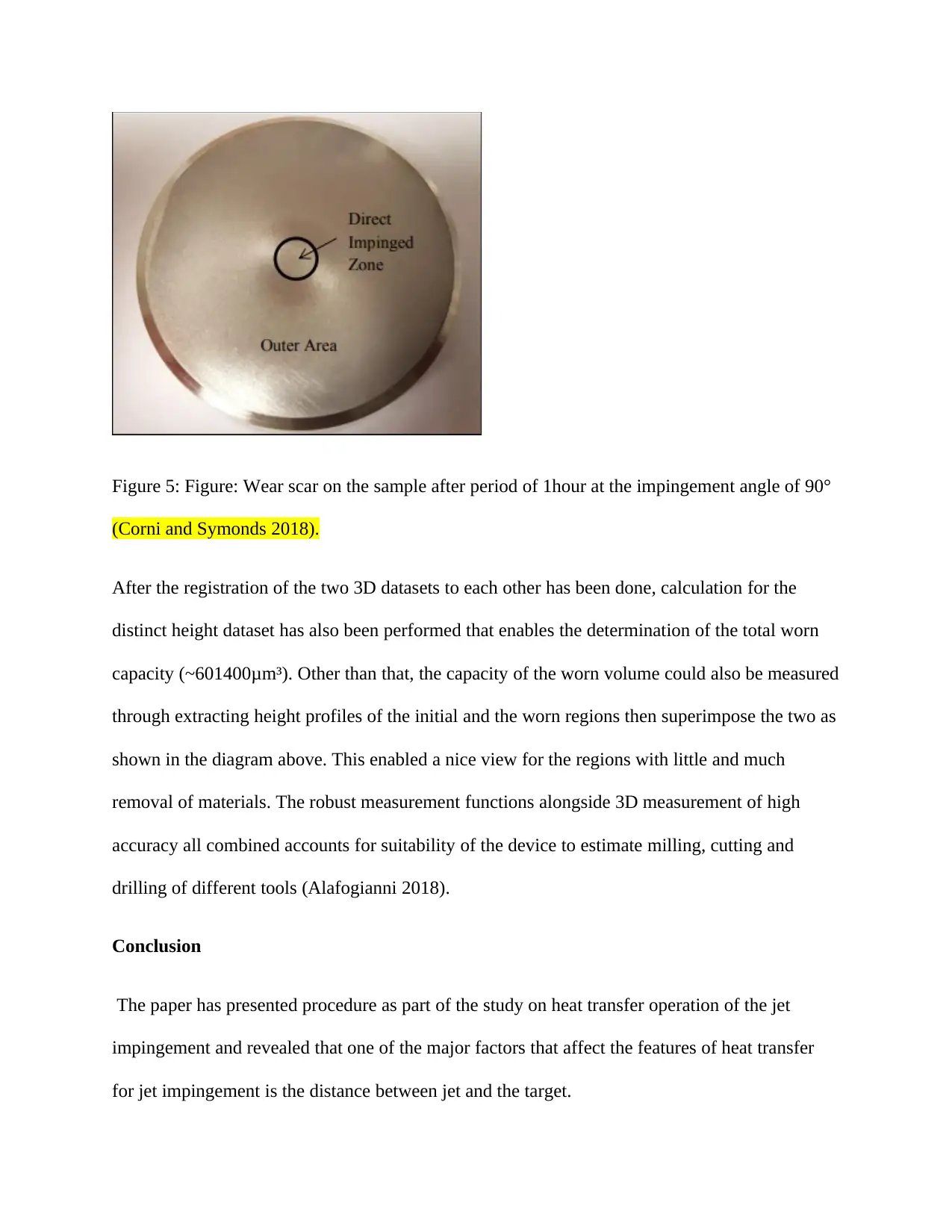
Figure 5: Figure: Wear scar on the sample after period of 1hour at the impingement angle of 90°
(Corni and Symonds 2018).
After the registration of the two 3D datasets to each other has been done, calculation for the
distinct height dataset has also been performed that enables the determination of the total worn
capacity (~601400μm³). Other than that, the capacity of the worn volume could also be measured
through extracting height profiles of the initial and the worn regions then superimpose the two as
shown in the diagram above. This enabled a nice view for the regions with little and much
removal of materials. The robust measurement functions alongside 3D measurement of high
accuracy all combined accounts for suitability of the device to estimate milling, cutting and
drilling of different tools (Alafogianni 2018).
Conclusion
The paper has presented procedure as part of the study on heat transfer operation of the jet
impingement and revealed that one of the major factors that affect the features of heat transfer
for jet impingement is the distance between jet and the target.
(Corni and Symonds 2018).
After the registration of the two 3D datasets to each other has been done, calculation for the
distinct height dataset has also been performed that enables the determination of the total worn
capacity (~601400μm³). Other than that, the capacity of the worn volume could also be measured
through extracting height profiles of the initial and the worn regions then superimpose the two as
shown in the diagram above. This enabled a nice view for the regions with little and much
removal of materials. The robust measurement functions alongside 3D measurement of high
accuracy all combined accounts for suitability of the device to estimate milling, cutting and
drilling of different tools (Alafogianni 2018).
Conclusion
The paper has presented procedure as part of the study on heat transfer operation of the jet
impingement and revealed that one of the major factors that affect the features of heat transfer
for jet impingement is the distance between jet and the target.
⊘ This is a preview!⊘
Do you want full access?
Subscribe today to unlock all pages.

Trusted by 1+ million students worldwide
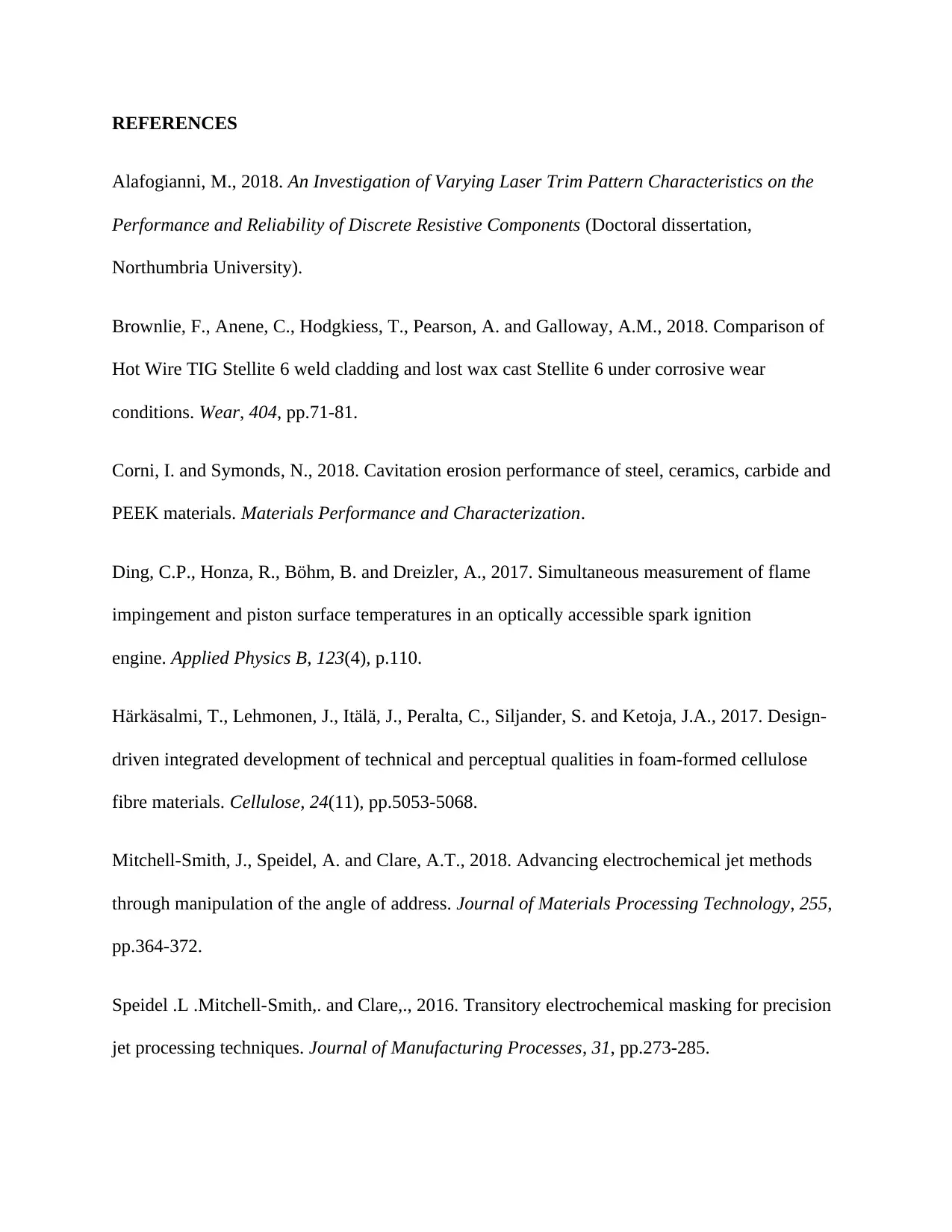
REFERENCES
Alafogianni, M., 2018. An Investigation of Varying Laser Trim Pattern Characteristics on the
Performance and Reliability of Discrete Resistive Components (Doctoral dissertation,
Northumbria University).
Brownlie, F., Anene, C., Hodgkiess, T., Pearson, A. and Galloway, A.M., 2018. Comparison of
Hot Wire TIG Stellite 6 weld cladding and lost wax cast Stellite 6 under corrosive wear
conditions. Wear, 404, pp.71-81.
Corni, I. and Symonds, N., 2018. Cavitation erosion performance of steel, ceramics, carbide and
PEEK materials. Materials Performance and Characterization.
Ding, C.P., Honza, R., Böhm, B. and Dreizler, A., 2017. Simultaneous measurement of flame
impingement and piston surface temperatures in an optically accessible spark ignition
engine. Applied Physics B, 123(4), p.110.
Härkäsalmi, T., Lehmonen, J., Itälä, J., Peralta, C., Siljander, S. and Ketoja, J.A., 2017. Design-
driven integrated development of technical and perceptual qualities in foam-formed cellulose
fibre materials. Cellulose, 24(11), pp.5053-5068.
Mitchell-Smith, J., Speidel, A. and Clare, A.T., 2018. Advancing electrochemical jet methods
through manipulation of the angle of address. Journal of Materials Processing Technology, 255,
pp.364-372.
Speidel .L .Mitchell-Smith,. and Clare,., 2016. Transitory electrochemical masking for precision
jet processing techniques. Journal of Manufacturing Processes, 31, pp.273-285.
Alafogianni, M., 2018. An Investigation of Varying Laser Trim Pattern Characteristics on the
Performance and Reliability of Discrete Resistive Components (Doctoral dissertation,
Northumbria University).
Brownlie, F., Anene, C., Hodgkiess, T., Pearson, A. and Galloway, A.M., 2018. Comparison of
Hot Wire TIG Stellite 6 weld cladding and lost wax cast Stellite 6 under corrosive wear
conditions. Wear, 404, pp.71-81.
Corni, I. and Symonds, N., 2018. Cavitation erosion performance of steel, ceramics, carbide and
PEEK materials. Materials Performance and Characterization.
Ding, C.P., Honza, R., Böhm, B. and Dreizler, A., 2017. Simultaneous measurement of flame
impingement and piston surface temperatures in an optically accessible spark ignition
engine. Applied Physics B, 123(4), p.110.
Härkäsalmi, T., Lehmonen, J., Itälä, J., Peralta, C., Siljander, S. and Ketoja, J.A., 2017. Design-
driven integrated development of technical and perceptual qualities in foam-formed cellulose
fibre materials. Cellulose, 24(11), pp.5053-5068.
Mitchell-Smith, J., Speidel, A. and Clare, A.T., 2018. Advancing electrochemical jet methods
through manipulation of the angle of address. Journal of Materials Processing Technology, 255,
pp.364-372.
Speidel .L .Mitchell-Smith,. and Clare,., 2016. Transitory electrochemical masking for precision
jet processing techniques. Journal of Manufacturing Processes, 31, pp.273-285.
Paraphrase This Document
Need a fresh take? Get an instant paraphrase of this document with our AI Paraphraser
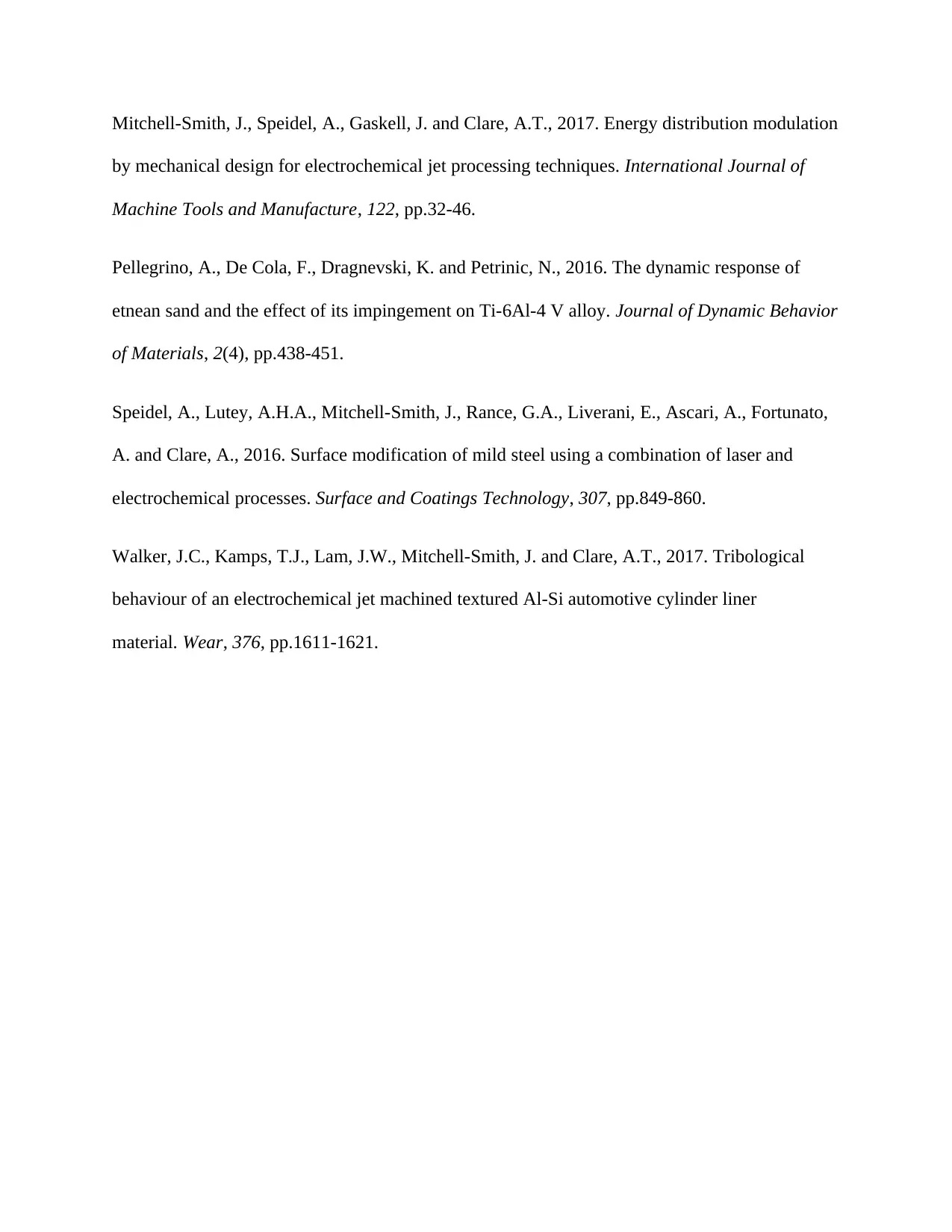
Mitchell-Smith, J., Speidel, A., Gaskell, J. and Clare, A.T., 2017. Energy distribution modulation
by mechanical design for electrochemical jet processing techniques. International Journal of
Machine Tools and Manufacture, 122, pp.32-46.
Pellegrino, A., De Cola, F., Dragnevski, K. and Petrinic, N., 2016. The dynamic response of
etnean sand and the effect of its impingement on Ti-6Al-4 V alloy. Journal of Dynamic Behavior
of Materials, 2(4), pp.438-451.
Speidel, A., Lutey, A.H.A., Mitchell-Smith, J., Rance, G.A., Liverani, E., Ascari, A., Fortunato,
A. and Clare, A., 2016. Surface modification of mild steel using a combination of laser and
electrochemical processes. Surface and Coatings Technology, 307, pp.849-860.
Walker, J.C., Kamps, T.J., Lam, J.W., Mitchell-Smith, J. and Clare, A.T., 2017. Tribological
behaviour of an electrochemical jet machined textured Al-Si automotive cylinder liner
material. Wear, 376, pp.1611-1621.
by mechanical design for electrochemical jet processing techniques. International Journal of
Machine Tools and Manufacture, 122, pp.32-46.
Pellegrino, A., De Cola, F., Dragnevski, K. and Petrinic, N., 2016. The dynamic response of
etnean sand and the effect of its impingement on Ti-6Al-4 V alloy. Journal of Dynamic Behavior
of Materials, 2(4), pp.438-451.
Speidel, A., Lutey, A.H.A., Mitchell-Smith, J., Rance, G.A., Liverani, E., Ascari, A., Fortunato,
A. and Clare, A., 2016. Surface modification of mild steel using a combination of laser and
electrochemical processes. Surface and Coatings Technology, 307, pp.849-860.
Walker, J.C., Kamps, T.J., Lam, J.W., Mitchell-Smith, J. and Clare, A.T., 2017. Tribological
behaviour of an electrochemical jet machined textured Al-Si automotive cylinder liner
material. Wear, 376, pp.1611-1621.
1 out of 11
Your All-in-One AI-Powered Toolkit for Academic Success.
+13062052269
info@desklib.com
Available 24*7 on WhatsApp / Email
![[object Object]](/_next/static/media/star-bottom.7253800d.svg)
Unlock your academic potential
Copyright © 2020–2025 A2Z Services. All Rights Reserved. Developed and managed by ZUCOL.

